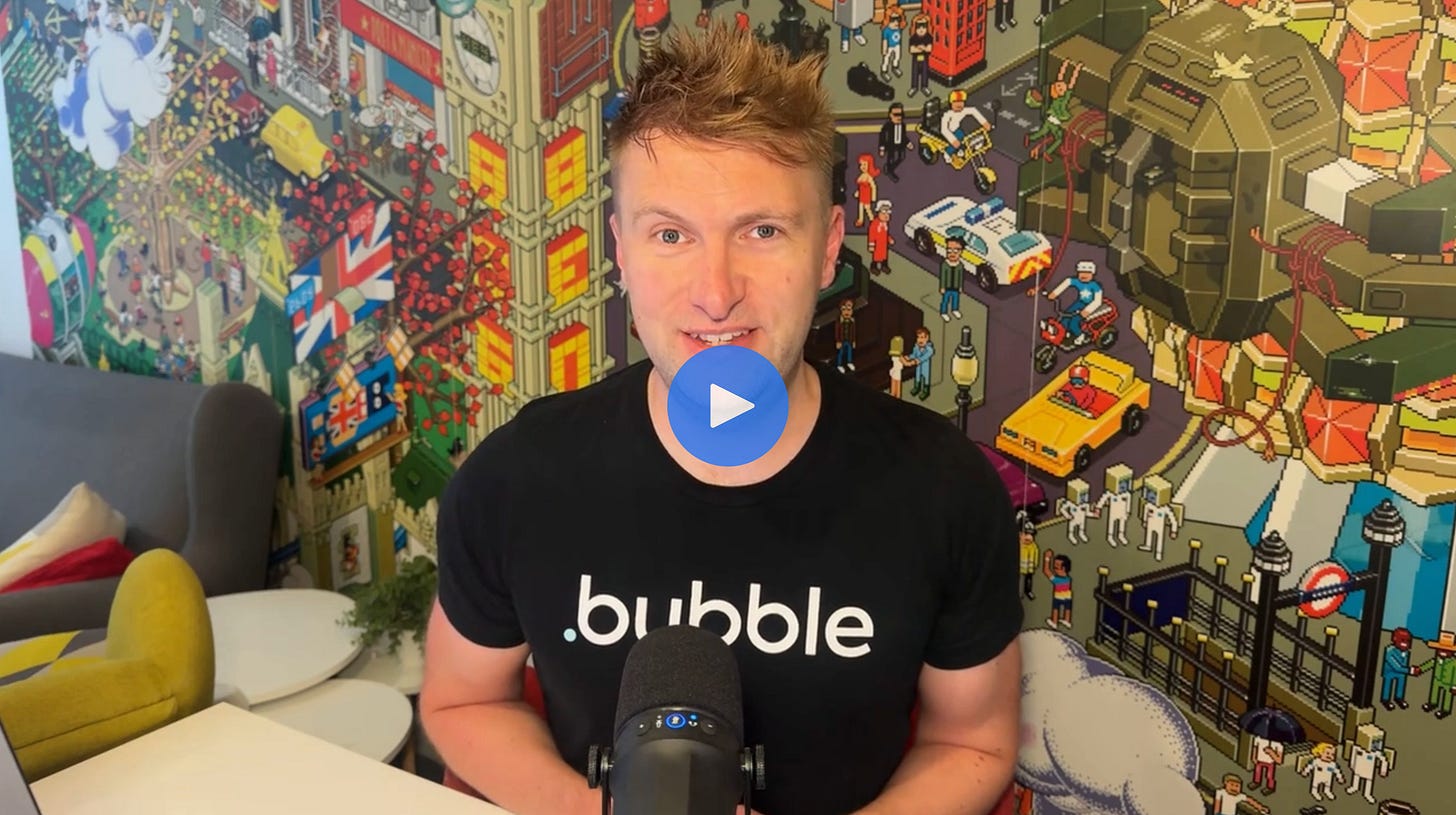How to scrape data from Instagram, X, YouTube and Google in your Bubble App
Setting up scraping from your Bubble App is easier than you think - and can open up a whole new world of product ideas. This week's video tutorial shows you how to do it in under 10 minutes.
Hey there,
It's James from the No Code SaaS newsletter. This is the newsletter where I take you along on my journey of building a profitable SaaS business without code.
This week we're diving into an alternative approach for getting certain types of data into your app - web scraping.
If you've ever wanted to pull in tweets, Instagram posts, or Google search results, this technique is well worth considering.
I've used it in a couple of apps myself and found it incredibly handy, it’s a really flexible way of getting all sorts of data into your app. Particularly useful for doing things like AI analysis.
Also in this week’s edition I’m running a contest for a free ticket to the Bubble conference in NYC taking place next month, BubbleCon. I’ll be speaking on the AI panel on Day 2 - so can’t wait to see you there.
If you’d prefer to dive in and watch the tutorial straight away, just click here.
Why Scraping?
Let's face it - many services like Twitter, Instagram, and Google either don't have APIs we can easily use, or they're heavily restricted.
Twitter's API limitations have become particularly onerous lately. This is where scraping services come in handy.
They're reliable, high-quality, and way easier to use than official APIs. Plus, there are far fewer restrictions - though you will likely have to pay to use them.
But in my experience it’s worth the cost compared the extra dev time, limitations and restrictions that often come with using official APIs.
With large scale providers like Apify maintaining the scrapers, all you have to do is set up an API call and forget about it, I’ve found it to be highly reliable with minimal issues.
What Can You Scrape?
The possibilities are vast, but here are some practical examples:
Social Media Content:
Twitter/X: Grab tweets, user profiles, or trending topics
Instagram: Fetch posts, stories, or user information
LinkedIn: Pull job postings, company updates, or user profiles
Search Engine Data:
Google: Capture search results, featured snippets, or local business listings
E-commerce Information:
Amazon: Product details, prices, reviews
Etsy: Handmade and vintage item listings
eBay: Auction data, seller ratings
News and Content:
News websites: Article headlines, summaries, full content
Blogs: Posts, comments, author information
YouTube: Video titles, descriptions, view counts
Travel and Hospitality:
TripAdvisor: Hotel reviews, ratings, pricing
Airbnb: Property listings, host information, availability
The Tool: Apify
In this week's tutorial, we're using Apify. It's like an app store for scrapers - thousands of pre-built options ready to go.
I've found it super reliable and it plays nice with Bubble. Best of all, it's dead simple to use.
How It Works
Choose Your Scraper: Apify has scrapers for almost everything. We're using their Instagram scraper as an example.
Configure: Set what you want to scrape (e.g., hashtags, number of posts).
Run: Execute the scraper through an API call.
Get Data: Receive structured JSON data ready to use in your Bubble app.
In my video tutorial, I walk through scraping Instagram posts with the #bubblecon2023 hashtag.
We set it up in Apify, create an API connector in Bubble, and then display the results on a page. It's that straightforward.
Why This Matters for Your SaaS
Rich Data: Enhance your app with real-world, current data without complex integrations.
Flexibility: Not limited by official API restrictions - scrape what you need.
Quick Implementation: Often faster to set up than official APIs, especially for prototypes or MVPs.
Cost-Effective: Many scrapers charge per result, allowing for better cost control.
Next Week: Leveling Up with AI
We're taking this a step further next week. I'll show you how to:
Run a scraping job
Process the results with AI (using Claude)
Return the processed data to Bubble
All of this happens on a Cloudflare worker, without writing any code.
Imagine scraping Instagram posts, categorizing them with AI, and returning the sorted data to your Bubble app - all in one go.
It's a powerful combo that opens up tons of possibilities - without using hardly any Bubble WUs!
Bubblecon Giveaway
Don't forget - I’m giving away a free ticket to Bubblecon! I'll be speaking on the AI panel on day two. If you're keen to attend, hit this link to enter. One lucky subscriber will snag that free ticket.
That’s it for this week!
Scraping can be a really handy tool have in your pocket for your Bubble apps. It lets you pull in data that might otherwise be out of reach - and it’s really useful when you’re trying to get data into your app to analyze with AI.
Give the tutorial a watch, and let me know if you have any questions or cool ideas for future issues - I always love hearing from you.
Catch you next week for our AI Cloudflare Worker deep-dive!
Cheers, James




bookmarking this!
Hi James. If I see referral hits in my Substack stats from a dedicated bubble instance like "d132.bubble.is" is that from an app that's scraping my newsletter content? If so, why would they be doing that? Thanks for any advice you can give.